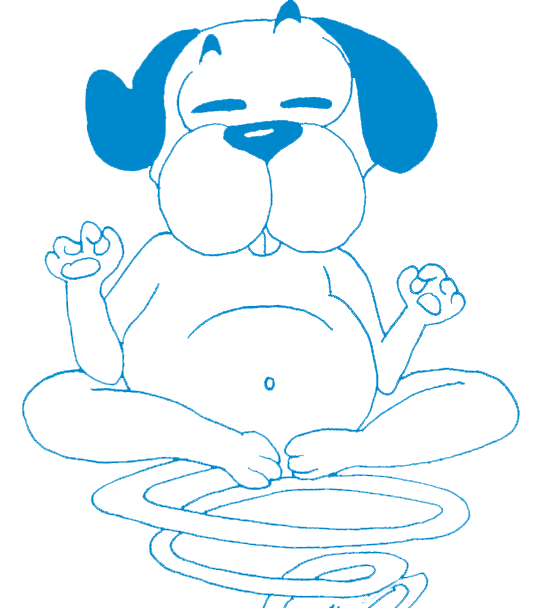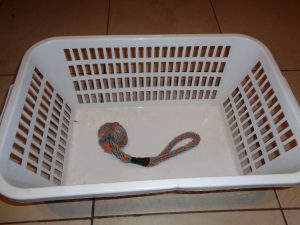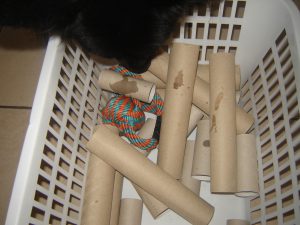What is it?
The idea is to suggest to our dogs to use their nose and resourcefulness to find a toy that we have hidden.
What do we need?
- Our dog’s favourite toy,
- A container (basket, cardboard box,…) adapted to the size of our dog who must be able to easily pick up an object at the bottom,
- Newspaper or empty rolls of toilet paper / kitchen paper.
Description and progression
For the game described below, let’s assume that we have chosen a basket, a toy and empty toilet paper rolls.
Step 1: Let’s settle down in a quiet room in the house (where our dog feels comfortable), put the toy in the basket, in full view of our dog. There are no other objects in the basket. As soon as he becomes interested in the toy (looks at it, approaches it, sniffs it, touches it with his muzzle or paw, takes it in the mouth,…), we reward him. We start again until our dog is interested in his toy in the most engaged way (each dog will naturally propose a mark: touching it with his paw, staring at it while barking or picking it up, for example). It is important for this game that our dog retrieves/relinquishes his toy. If he doesn’t do it naturally, we will teach him during specific play sessions.
|
|
|
Step 2: In the same room in the house, in the same basket, let’s place a few cardboard rolls and place the toy among the rolls, in full view of our dog. The toy remains visible despite the rolls. As soon as he retrieves/gives us his toy, we reward him.
Only one parameter changes between two stages of the exercise: either the container, or out of the dog’s sight, or the environment, or the visibility of the object.
|
|
Step 3: In the same room of the house, in the same basket, let’s place even more cardboard rolls and drop the toy into the rolls, in front of our dog. The toy is almost hidden among the roll. As soon as he retrieves his toy, we reward him.
![]() Video: Toy in a basket with more rolls
Video: Toy in a basket with more rolls
Step 4: In the same room of the house, in the same basket, place the toy and cover it with rolls, in front of our dog. The toy is totally hidden among the rolls. As soon as he retrieves his toy, he gets rewarded.

Step 5: In the same room of the house, in the same basket, place some cardboard rolls and place the toy among the rolls, while the dog is not watching. The toy is visible despite the rollers. As soon as he retrieves his toy, we reward him.
When a new parameter creates too much difficulty (dog not watching, for example), we can decrease the level of difficulty of one of the other parameters (fewer rolls for example).
![]() Video: Hidden toy in a basket out of sight of Koumack
Video: Hidden toy in a basket out of sight of Koumack
Step 6: In the same room of the house, in the same basket, place the toy and cover it with rolls, while the dog is not watching. The toy is totally hidden among the rolls. As soon as he retrieves his toy, we reward him.
Next steps: Start all over again … with new containers (cardboard box or a suitcase that can be closed, a bush or hedge in the garden, …) or other objects (new toy, wallet, phone, …).
![]() Video: Toy hidden in the garden
Video: Toy hidden in the garden
![]() Video: Toy hidden under a wooden box
Video: Toy hidden under a wooden box
![]() Video: Toy hidden in the garden for Nano
Video: Toy hidden in the garden for Nano
Learning without pressure
These game sessions must be very short (less than 5 minutes and a maximum of 3 sessions during the day). Each session involves reflection and scent work which require a lot of concentration from our dog. If the session is too long or if we repeat too many sessions on the same day, we risk failure. It is better to stop on a positive note, even if it seems to us that the last game proposed was very easy to perform. Beginners need time to develop their skills as they go along. And let’s not forget that learning takes place optimally when the dog is not stressed and therefore not put under pressure.
In the same vein, there is no need to “motivate” our dog by repeating the request (“search” for example). While our dog is focused on the track of the lost object, he mainly uses his sight and sense of smell. Repetitions of “search”, “search”, “search” distract him and overwhelm his ears and brain with unnecessary information. This is only distraction, not motivation.
There is no need to help them unduly, for example, by pointing to the location of the hidden object. Staring at the object and turning completely towards it are already important indications. The game is for our dogs to develop their olfactory skills, it is not a game of speed or performance. When our dog stops searching, the game is over, either temporarily because a few moments of rest will be enough for him, or permanently depending on our dog. Let’s respect his learning pace.
Let’s also respect his recovery pace: a busy weekend means a greater need for rest. The ideal is then to offer our dog an easier search game: a few treats scattered, without hiding them, at home or in the lawn will do the trick (see “treat search“).
Those who do not cope
If our dog is not interested in the toy, let’s ask ourselves how to make it more interesting. We can use a new toy (novelty appeal), a pencil case in which to hide treats (a sock with a knot in it can also contain treats). We can also offer it a special treat (a tasty reward to chew, for example). It’s up to us to offer him an interesting and attractive object.
If our dog likes the object but he is not interested in finding it, it is probably because it is too difficult for him (physically if our dog is old, sick or injured / emotionally if our dog is not at ease in the environment for example / if we have skipped steps in the learning process / if the container is challenging or scary). It is up to us to offer him a game that matches his physical and/or emotional abilities.
Some dogs could also accept playing with certain objects but not with others: metal keys for example are not very pleasant to play with.
On the other hand, if our dog “likes” the container or camouflage objects “too much”, he might give them his full attention and forget about the toy. Our dog could also feel pressured and will prefer to destroy or shred the container (quick fix) rather than try to calmly solve the problem. It is up to us to take into account our dog’s tolerance level.
![]() Video: Koumack prefers the box over his hidden toy
Video: Koumack prefers the box over his hidden toy
TAKEAWAY
- Offer an exceptional object / treat appreciated by our dog;
- Choose suitable containers;
- Increase the difficulty, step by step;
- Offer learning without pressure;
- Short sessions are a must;
- Offer a game adapted to our dog’s needs, expectations and abilities.



